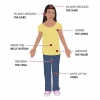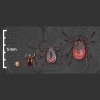Subscribe to Stay Informed
Marshall County Health Department recommending people check themselves after outdoor activities due to increased tick encounters
Posted 07/20/21
Lyme disease (LD) is the most commonly reported tickborne disease in West Virginia. Last year, 1,062 LD cases were reported in the state and a dramatic increase in cases was seen in northwestern and central West Virginia. Recently tick bite-related emergency department visits have increased in West Virginia. This trend is expected, as tick exposures generally increase during spring and summer months and serves as an important reminder that tickborne diseases occur annually in West Virginia.
The geographic range of some ticks that spread germs also continues to increase. One example is the lone star tick, which transmits the pathogens that cause ehrlichiosis, tularemia, and Heartland virus disease. The lone star tick continues to expand from its original territory in the southeastern United States into the northern and mid-western states. The number of counties with the blacklegged ticks responsible for most cases of Lyme disease, babesiosis, and anaplasmosis in the United States also has more than doubled over the past twenty years.
Take steps to protect against tick bites:
Taking steps to protect yourself and your family from getting a tick bite is the best defense against tickborne diseases.
The CDC recommends that people:
- Avoid areas with high grass and leaf litter and walk in the center of trails when hiking.
- Use Environmental Protection Agency (EPA)-registered insect repellents containing DEET, picaridin, IR3535, oil of lemon eucalyptus, para-menthane-diol, or 2-undecanone.
- EPA’s search tool can help you find the product that best suits your needs. Always follow product instructions.
- Use products that contain permethrin to treat clothing and gear, such as boots, pants, socks and tents or look for clothing pre-treated with permethrin.
- Treat dogs for ticks. Dogs are very susceptible to tick bites and to some tickborne diseases. They may also bring ticks into your home. Talk to your veterinarian about the best tick prevention products for your dog.
- Bathe or shower as soon as possible after coming indoors to wash off and more easily find crawling ticks before they bite you.
- Conduct a full-body tick check using a hand-held or full-length mirror to view all parts of your body upon returning from tick-infested areas. Parents should help children check thoroughly for ticks. Remove any ticks right away.
- Put dry clothes in a dryer on high heat for 10 minutes to kill ticks after you come indoors. If the clothes are damp, dry thoroughly and then tumble dry on high for 10 more minutes.
Common Places to check for Ticks
Tick Size Scale on a dime


